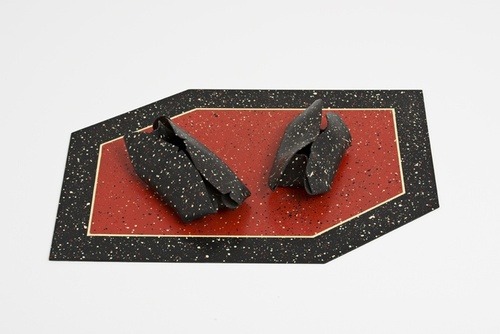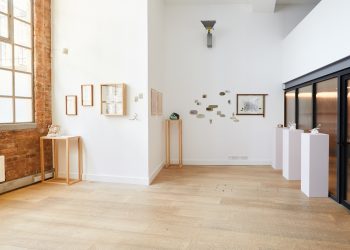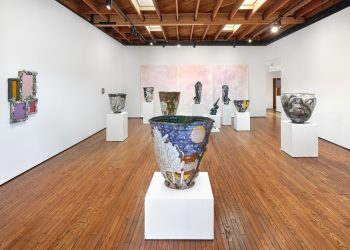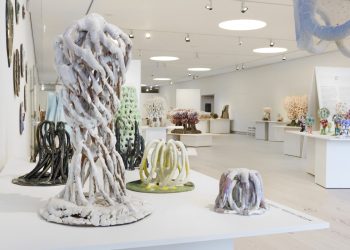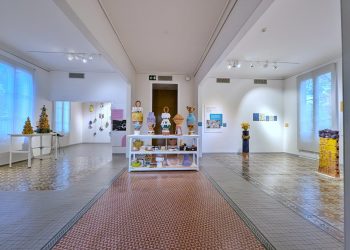
Hannah Wilke: Sculpture 1960s-’80s / Alison Jacques Gallery, London
April 24 – May 29, 2014
Alison Jacques is proud to present its fourth solo exhibition of the late American artist Hannah Wilke (1940 – 1993). For this show, the focus is on Wilke’s sculpture from her early terracotta works of the ‘60s through to the more richly coloured installations of the ‘80s. The show also encompasses the theme of her body as sculpture seen in performative photographs as well as drawings from the ‘60s and ‘70s which either refer to her sculptures or demonstrate a visceral physicality that feels completely in dialogue with her sculptural practice.
The gallery has worked in partnership with The Hannah Wilke Collection & Archive, Los Angeles, who have enabled us to assemble a succinct survey of iconic and lesser-known works which shed light on the many aspects of Wilke’s sculptural vocabulary. One of her earliest and most important sculptures That Fills Earth, (1965) is an earthy terracotta cube opening into organic forms. By pairing this explicit symbol of Modernism: the cube, with quasi-Metaphysical essentialism, Wilke demonstrates an idea of the “Modern Woman” – deconstructing a complicated living being into an ostensibly simplistic material form.
The show continues with a survey of sculptures that have been widely identified by scholars but rarely seen in public – from a trio of bronze sculptures, Athens (1979) to examples of her Generation Process Series grid groups from the mid-1980s. In each of the latter, Wilke placed hand-painted ceramic sculptures in geometric arrangements across painted boards, employing colour, pattern and her signature folded-gesture forms to both acknowledge and subvert her male contemporaries’ obsession with the mathematics of grid systems.
The main focus of the show is Wilke’s choice of materials and what they represent. In the exhibition catalogue to accompany Gestures, the most comprehensive survey of Wilke sculpture to date (Neuberger Museum, New York, 2008), the curator Tracy Fitzpatrick states:
“Wilke’s practice is rooted in her devotion to malleability and her interest in vulnerability. Throughout her career she created art from unusual materials, plastic and fragile in composition, and then placed these objects in compromising situations – hinged with pins or glued to walls and boards, placed freely on the floor, always seemingly on the verge of disaster, always questioning: Will it fall? Will it crack? This vulnerability, so much a part of Wilke’s work, is also carefully constructed strategy, perilous but orchestrated by the artist. The combination of these seemingly opposing forces creates a unique tension throughout her artistic production.”
An area of Wilke’s work, which is shown here in depth, are the kneaded erasers series from the 1970s, in which Wilke used simple everyday grey colour erasers and adapted this material into an entire series of work. Wilke placed her kneaded erasers, moulded into little gestural folded forms, onto various surfaces including boards on plinths but also everyday utensils such as Fork and Spoon (1974) and vintage postcards including Sea Wall (1975), and The Beach, The Pines, Cotuits, Mass (1977). Other materials including Wilke’s signature chewing gum are present in the show, from photographs which make up the iconic SOS series to her lesser known large-scale photographic work called California Series where Wilke photographed her gum sculptures outdoors attached to foliage and flowers.
Earlier this year, The Guardian newspaper described Hannah Wilke as “one of the most subversive women artists in history”. Throughout this exhibition, in whatever medium her sculptural forms reside, we are constantly reminded that Wilke saw no contradiction between creating pioneering, confrontational works that helped redefine the extent of feminist activism, whilst creating aesthetically pleasing forms. Wilke was an unapologetic aesthete, stating in an interview with Lil Picard in 1973: “The concept of the disagreeable object had offended me, and I decided to make ‘agreeable objects’. I don’t feel happy on any level with disagreeable forms – I love beautiful things”.
Hannah Wilke (b. New York, NY, 1940; d. Houston, TX, 1993) trained at Stella Elkins Tyler School of Fine Art, Temple University, Philadelphia. Key solo museum exhibitions during her life included Hannah Wilke: Scarification Photographs and Videotapes, Fine Arts Gallery, University of California, Irvine, (1976); and Hannah Wilke: A Retrospective, University of Missouri (1989). Recent solo presentations of her work include Hannah Wilke: Gestures, Neuberger Museum of Art, New York (2008). Wilke has also been included in significant group exhibitions, including: Human Nature, LACMA, Los Angeles, CA (2012); Naked Before the Camera, Metropolitan Museum of Art, New York (2012); The Original Copy: Photography of Sculpture, 1839 to Today, MoMA, New York, NY (2010) and elles@centrepompidou, Centre Pompidou, Paris, (2010). Her work features in major museum and foundation collections including Tate, London; Centre Pompidou, Paris; Museum of Modern Art, New York; Whitney Museum of American Art, New York; Solomon R. Guggenheim Museum, New York; LA County Museum of Art, Los Angeles; Museum of Contemporary Art, Los Angeles, Princeton University Art Museum; and Coleccion Jumex, Mexico City.
Gallery hours: Tuesday to Saturday, 10 am – 6 pm or by appointment.
CONTACT
info@alisonjacquesgallery.com
Tel. +44 (0)20 7631 4720
Alison Jacques Gallery
16-18 Berners Street
London W1T 3LN
United Kingdom
www.alisonjacquesgallery.com
Above: Hannah Wilke, Support, Foundation, Comfort, 1984, Two painted ceramics on painted board, (A) 8.9 x 23.5 x 10.8 / (B) 8.3 x 20.3 x 9.5 / (board) 61 x 45.7 cm. Hannah Wilke Collection & Archive, Los Angeles. © Marsie, Emanuelle, Damon, and Andrew Scharlatt/VAGA, New York/DACS, London.
More exhibitions / View the list of ceramic art exhibitions


